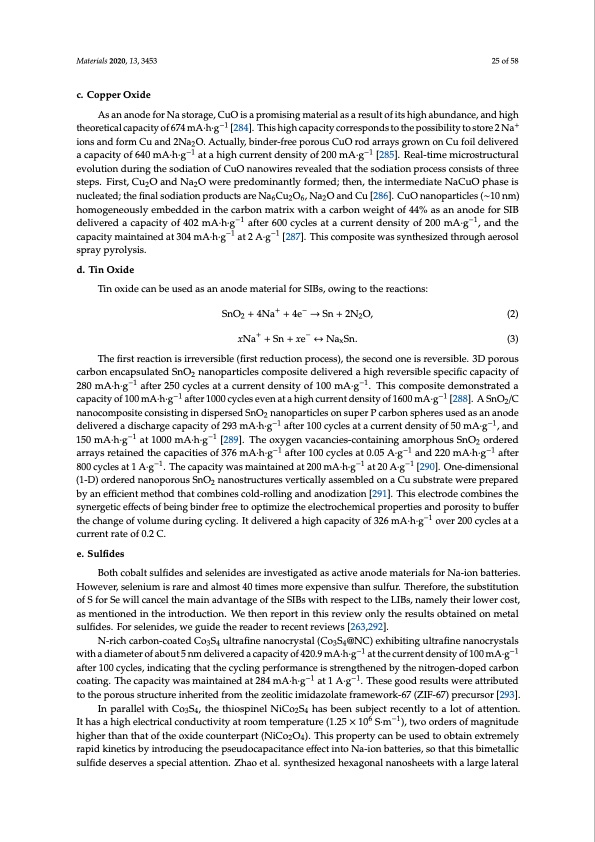
PDF Publication Title:
Text from PDF Page: 025
Materials 2020, 13, 3453 25 of 58 c. Copper Oxide As an anode for Na storage, CuO is a promising material as a result of its high abundance, and high theoretical capacity of 674 mA·h·g−1 [284]. This high capacity corresponds to the possibility to store 2 Na+ ions and form Cu and 2Na2O. Actually, binder-free porous CuO rod arrays grown on Cu foil delivered a capacity of 640 mA·h·g−1 at a high current density of 200 mA·g−1 [285]. Real-time microstructural evolution during the sodiation of CuO nanowires revealed that the sodiation process consists of three steps. First, Cu2O and Na2O were predominantly formed; then, the intermediate NaCuO phase is nucleated; the final sodiation products are Na6Cu2O6, Na2O and Cu [286]. CuO nanoparticles (∼10 nm) homogeneously embedded in the carbon matrix with a carbon weight of 44% as an anode for SIB delivered a capacity of 402 mA·h·g−1 after 600 cycles at a current density of 200 mA·g−1, and the capacity maintained at 304 mA·h·g−1 at 2 A·g−1 [287]. This composite was synthesized through aerosol spray pyrolysis. d. Tin Oxide Tin oxide can be used as an anode material for SIBs, owing to the reactions: SnO2 +4Na+ +4e− →Sn+2N2O, (2) xNa+ + Sn + xe− ↔ NaxSn. (3) The first reaction is irreversible (first reduction process), the second one is reversible. 3D porous carbon encapsulated SnO2 nanoparticles composite delivered a high reversible specific capacity of 280 mA·h·g−1 after 250 cycles at a current density of 100 mA·g−1. This composite demonstrated a capacity of 100 mA·h·g−1 after 1000 cycles even at a high current density of 1600 mA·g−1 [288]. A SnO2/C nanocomposite consisting in dispersed SnO2 nanoparticles on super P carbon spheres used as an anode delivered a discharge capacity of 293 mA·h·g−1 after 100 cycles at a current density of 50 mA·g−1, and 150 mA·h·g−1 at 1000 mA·h·g−1 [289]. The oxygen vacancies-containing amorphous SnO2 ordered arrays retained the capacities of 376 mA·h·g−1 after 100 cycles at 0.05 A·g−1 and 220 mA·h·g−1 after 800 cycles at 1 A·g−1. The capacity was maintained at 200 mA·h·g−1 at 20 A·g−1 [290]. One-dimensional (1-D) ordered nanoporous SnO2 nanostructures vertically assembled on a Cu substrate were prepared by an efficient method that combines cold-rolling and anodization [291]. This electrode combines the synergetic effects of being binder free to optimize the electrochemical properties and porosity to buffer the change of volume during cycling. It delivered a high capacity of 326 mA·h·g−1 over 200 cycles at a current rate of 0.2 C. e. Sulfides Both cobalt sulfides and selenides are investigated as active anode materials for Na-ion batteries. However, selenium is rare and almost 40 times more expensive than sulfur. Therefore, the substitution of S for Se will cancel the main advantage of the SIBs with respect to the LIBs, namely their lower cost, as mentioned in the introduction. We then report in this review only the results obtained on metal sulfides. For selenides, we guide the reader to recent reviews [263,292]. N-rich carbon-coated Co3S4 ultrafine nanocrystal (Co3S4@NC) exhibiting ultrafine nanocrystals with a diameter of about 5 nm delivered a capacity of 420.9 mA·h·g−1 at the current density of 100 mA·g−1 after 100 cycles, indicating that the cycling performance is strengthened by the nitrogen-doped carbon coating. The capacity was maintained at 284 mA·h·g−1 at 1 A·g−1. These good results were attributed to the porous structure inherited from the zeolitic imidazolate framework-67 (ZIF-67) precursor [293]. In parallel with Co3S4, the thiospinel NiCo2S4 has been subject recently to a lot of attention. It has a high electrical conductivity at room temperature (1.25 × 106 S·m−1), two orders of magnitude higher than that of the oxide counterpart (NiCo2O4). This property can be used to obtain extremely rapid kinetics by introducing the pseudocapacitance effect into Na-ion batteries, so that this bimetallic sulfide deserves a special attention. Zhao et al. synthesized hexagonal nanosheets with a large lateralPDF Image | Electrode Materials for Sodium-Ion Batteries

PDF Search Title:
Electrode Materials for Sodium-Ion BatteriesOriginal File Name Searched:
materials-13-03453-v2.pdfDIY PDF Search: Google It | Yahoo | Bing
Salgenx Redox Flow Battery Technology: Salt water flow battery technology with low cost and great energy density that can be used for power storage and thermal storage. Let us de-risk your production using our license. Our aqueous flow battery is less cost than Tesla Megapack and available faster. Redox flow battery. No membrane needed like with Vanadium, or Bromine. Salgenx flow battery
| CONTACT TEL: 608-238-6001 Email: greg@salgenx.com | RSS | AMP |